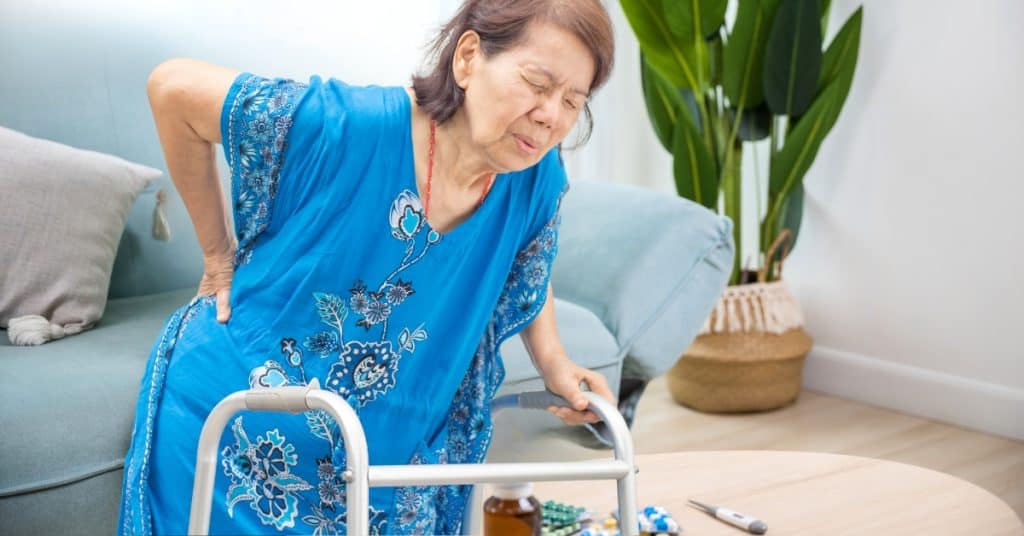When was the last time you heard a loved one complain about pain? Perhaps it was your mother wincing as she went about house chores, or your father skipping his daily walk because his knees hurt too much. What if their suffering isn't inevitable – and that you can do something for them?
In this article, we discuss different types of pain and treatment options available. We will also examine how untreated pain can cascade into other health issues, and most importantly, show you practical steps to take action when you or someone you care about is suffering.
Table of Contents
Pain: Your Body’s Alarm System
Pain is the body’s natural way of protecting us. It’s an alert system triggered when our body perceives potential harm or damage. It could be as minor as touching a hot stove or as serious as the symptoms of an illness or injury. Think of it as your body’s way of saying, “Something might be wrong, you need to pay attention.”
In some cases, our body handles the response automatically. For instance, when you touch something too hot, you instinctively pull your hand away. But there are times when pain persists, and the solution isn’t as straightforward. In those situations, we rely on medical professionals to identify the underlying issue and help us address it.
Yet, all too often, we ignore the alarm, hoping the pain will subside on its own or believe we can "get used to it." Unfortunately, ignoring pain when it demands attention can have serious consequences. It may lead to complications of the underlying conditions, long-term disability, and a diminished quality of life.
That is why understanding your pain is so important. By learning to recognise its nature and “message”, you’ll know when and how to seek help.
Know Your Pain
Pain generally falls into two main categories - acute and chronic.
Acute pain often strikes suddenly and intensely. It usually has a clear cause, such as a twisted ankle, a burn, or pain after surgery. Because it is obvious and demands immediate attention, people are more likely to report and seek medical care for it.
Chronic pain, however, tells a different story. Defined as pain lasting three months or more, it is often less intense but persistent. Many people overlook or try to “live with" chronic pain, leading to unnecessary suffering that could be treated effectively.
For the elderly, chronic pain may arise from a variety of sources, including:
- Musculoskeletal Conditions: These are conditions involving the muscles, bones, and joints. Common examples include arthritis, chronic back pain, degenerative disc disease, and injuries from falls, such as fractures, sprains, or soft tissue damage.
- Nerve-Related Pain: Pain associated with nerve damage may result from complications due to a stroke, diabetes (diabetic neuropathy), a spinal injury, or shingles (post-herpetic neuralgia).
- Circulatory Problems: Conditions such as peripheral vascular disease or deep vein thrombosis can cause cramping or aching pain in the legs, while hypertension or heart disease may manifest as recurrent headaches or chest pain.
- Pressure and Mobility Issues: Seniors with limited mobility may experience pain from muscle weakness and stiffness due to reduced activity or from pressure injuries (bedsores) caused by prolonged immobility.
- Internal Organ Pain: Common sources are the digestive and urinary systems, causing abdominal pain due to chronic constipation, diverticulitis, or urinary retention. Cancer-related pain is another significant source and is frequently undertreated.
In some cases, chronic pain has no identifiable cause. It may persist after an initial injury has healed or stem from long-term medical conditions. Regardless of the origin, seeking medical advice is essential to alleviate pain and related symptoms, manage the underlying condition, and improve your overall health and quality of life.
The Impact of Untreated Pain
There is a common misconception that tolerating pain will increase your tolerance and help you "get used to it." However, this approach is not proven and can often backfire.
“Pain can significantly impact quality of life, leading to physical and emotional exhaustion. For example, unaddressed pain can contribute to a cascade of issues such as loss of sleep, poor appetite, reduced mobility, disability, social isolation, anxiety and even depression. These, in turn, can lead to further complications like muscle deconditioning, pressure sores, constipation, and urinary retention. It becomes a vicious cycle,” explains Dr Alethea Chew - Lead Physician at Ninkatec.
A study shows that 1 in 5 adults aged 60 and older in Singapore report chronic pain, and a significant proportion suffer from pain-related disability. The risk is higher among women and elderly people with chronic health conditions. This highlights the importance of early intervention and proper pain management. Yet, seeking treatment for pain isn’t always straightforward.
"Many patients and caregivers don’t realise that medical care can effectively address their pain. Some suffer in silence, thinking over-the-counter painkillers or patches are enough. Others wait until the pain becomes unbearable, which makes treatment much less effective. Understanding when and how to seek help is a crucial first step in managing pain effectively," observes Dr Alethea Chew.
When and How to Talk to Your Doctor about Pain
The general rule of thumb is that you should seek medical care for pain when:
- You experience severe or intense pain
- The pain is moderate but does not go away or get better after a few days
- The pain worsens over time.
You don’t have to wait until the pain is unbearable to pay your doctor a visit. Trying to endure or “tahan” pain doesn’t make it go away faster or increase your tolerance. Addressing pain early can prevent it from worsening and help improve your quality of life.
Your doctor can help identify the cause and guide you toward effective treatment, but providing them with a clear and detailed description of your pain is essential for an accurate diagnosis. Pain isn’t something your doctor can directly “see” or feel. They rely on your self-report and may ask a series of questions to better understand your pain:
- Location: Where exactly is the pain?
- Radiation: Does the pain spread to other areas?
- Onset: When did it start? Was it sudden or gradual?
- Character: How does it feel? Is the pain tingling, throbbing, pulsating, sharp, or dull?
- Temporal Pattern: Does the pain come and go, or is it constant?
- Exacerbating and Relieving Factors: What makes it worse or better?
- Intensity: How severe is the pain on a scale from 1 to 10?
You may also be asked about other symptoms you experience and your medical history.
Accurately describing the sensations and characteristics of your pain allows your doctor to pinpoint the underlying cause and tailor treatment to your specific needs. It is important to neither downplay nor exaggerate your symptoms. If you are a caregiver, you can ask your loved one these questions in advance to assist the diagnosis process during a doctor’s visit.
Treatment for Pain
Treatment for pain can involve medication-based approaches as well as non-medication therapies, depending on the diagnosed cause.
Relieving Pain With Medication
Most of us reach for over-the-counter painkillers like paracetamol or ibuprofen when dealing with aches and pain. However, beyond these familiar options, a variety of prescription medications are available to address specific types of pain. Here are the main types:
- Topical treatments in the form of creams and patches to soothe pain at the source
- Anti-inflammatory medications to reduce both pain and swelling
- Muscle relaxants to ease muscle tension and discomfort
- Specialised anticonvulsants to tackle nerve pain
- Certain antidepressants that have proven effective against chronic pain
- Opioids of varying strengths for severe pain management
These medications come in different forms, including traditional tablets, skin patches, topical applications, and subcutaneous (under the skin) injections. Each delivery method is designed to provide optimal relief based on the type and severity of pain.
Safety First: Understanding Side Effects of Pain Medications
While pain medications can be highly effective, they may cause side effects and therefore, require careful consideration. Some patients may experience stomach discomfort, drowsiness, nausea or skin irritation when using patches. It is important to note that most pain medications, when used as prescribed, don't cause dependency. Even opioids, which carry addiction risks, are safe when taken exactly as directed by your doctor.
Seniors may be more susceptible to side effects due to slower metabolism, reduced kidney and liver function, and potential drug interactions with other medications they are taking. To ensure safe and effective pain management, Dr Alethea Chew advises that you:
- Inform your doctor about all medications and therapies you are taking to avoid potential interactions.
- Use medications strictly as prescribed by your doctor.
- Report any side effects you experience so adjustments can be made promptly.
- Explore alternative or complementary therapies, such as physiotherapy, for additional pain relief.
Relieving Pain Without Medication
Non-pharmacological pain management strategies can offer significant relief and work well alongside or as alternatives to medication. These approaches include physical therapy, massage, acupuncture, heat and cold therapy, mindfulness techniques, and gentle exercise programs tailored to your condition.
Note that "without medication" doesn't mean a doctor is not necessary. It is important to discuss your pain management plan with your primary doctor, especially if it relates to underlying conditions which you are already undergoing treatment for. This ensures that your pain management is both effective and safe.
Holistic Palliative Care for Pain
When pain is caused by or associated with a life-threatening condition such as cancer, late-stage dementia, kidney failure, heart failure, or other serious illnesses, standard pain management approaches may not be sufficient to address the complex needs of patients and their families. Palliative care represents a comprehensive approach to pain management that goes beyond simply treating symptoms.
This specialized medical care approach focuses on providing relief from pain and other distressing symptoms while improving overall quality of life for patients facing serious illnesses and their families. This is essential because sometimes, physical pain isn't the only type of pain a patient has to endure. There can be emotional and psychological suffering that medication alone can't treat.
Palliative care takes a holistic view that addresses:
- Physical pain through expertly managed medication regimens and comfort measures
- Emotional and psychological support for both patients and families
- Spiritual care tailored to individual beliefs and values
- Practical support with daily activities and care coordination
- Family education and caregiver support
Our palliative care services bring this comprehensive approach directly to your home, ensuring comfort and dignity while supporting the entire family through challenging times. Learn more about our palliative care programs and how they can enhance pain management for you or your loved one.
Takeaway Message
Pain is treatable, and it is not an inevitable part of ageing or something you must silently endure. While complete elimination of pain may not always be possible, modern medicine and therapeutic approaches offer effective ways to manage it and enhance your quality of life - preventing the downward spiral that untreated pain can cause.
The key is to explore your options and take proactive steps. Seeking help for pain is not a sign of weakness or a burden to your loved ones. Whether through medication, complementary therapies, a combination of treatments or palliative care, a path to relief is almost always possible. With time, persistence, and the right care, you can reclaim control and improve your quality of life.








